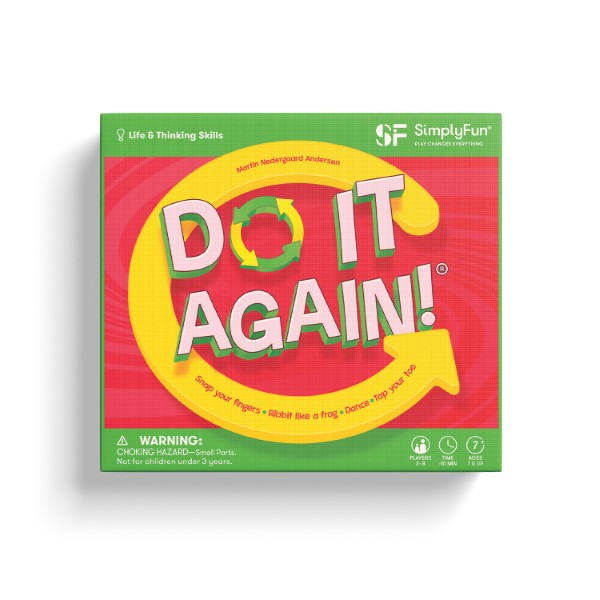
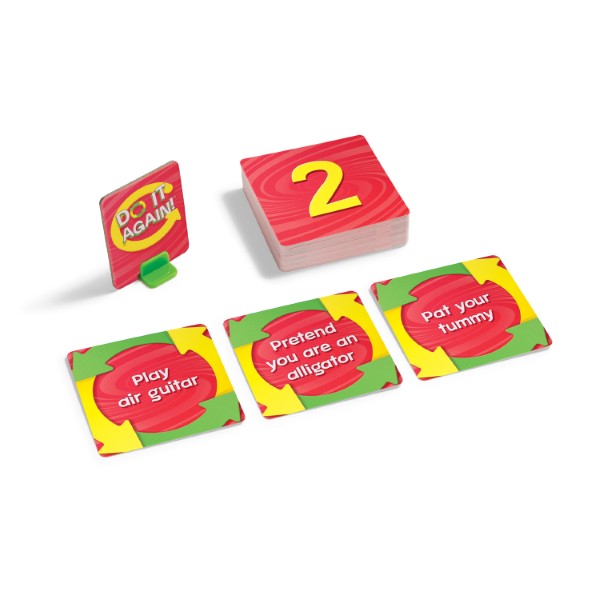
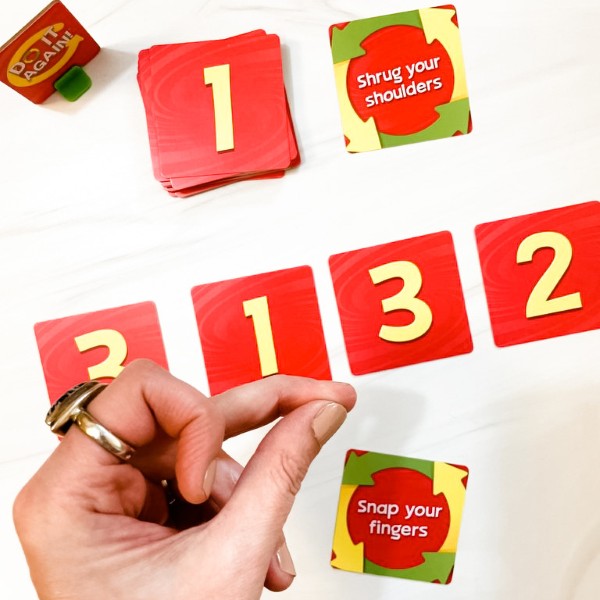
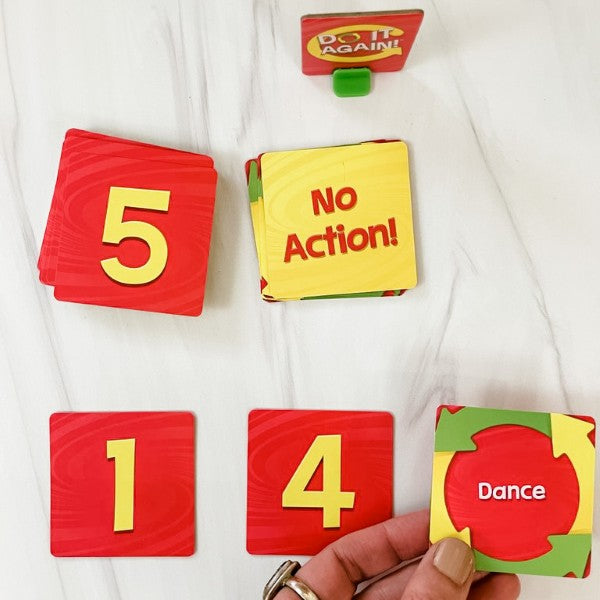
Collapsible content
Memorize a series of movements and act them out in the right order and you’ll be the last person standing in Simply Fun’s Do It Again!
Do It Again! can be played with as few as 2 or as many as 8 players, who should be age 7 or up to play.
Do It Again! comes with:
65 two-sided sequence cards with numbers on the back side and instructions for activities or sounds or movements on the front side, and…
…1 Do It Again! pawn that goes around from player to player, according to numbers on the cards. When it stops in front of you, it’s your turn!
To set up the game, shuffle the deck of Sequence cards and place the stack, number side up in the center of the play area. This is the draw pile. Place the pawn next to the cards.
To start the game, the first player takes the pawn and moves it counterclockwise from player to player according to the number on the top card in the draw pile. For example, if the number is 3, the player moves the pawn 3 players. If there are fewer players than the number, keep going around until the number is reached.
When the pawn stops, it’s that players turn.
On a given player’s turn, he draws the top sequence card and reads the front side.
If the card says No Action! then no action is taken and the card is placed face up in the discard pile. That player’s turn is over and he becomes the pawn mover for the next round.
If the card says an action, the player must complete the action to start or extend the sequence. The sequence is a series of movements or sounds that a player must perform to complete their turn and stay in the game. If no sequence has already been started, the action simply becomes the first action in a new sequence.
If actions have already begun a sequence, the player must perform each of the preceding actions in the existing sequence, from memory, in the correct order, before performing the new action on the card.
For example. If the previous action cards said: flex your arm muscles, cross your eyes, and pretend you are an alligator, and the new card says, dance, the player must do all of those action in the correct sequence in order to stay in the game.
A sequence continues to grow as long as all the players perform it correctly on their turn.
When a player successfully completes the sequence, and stays in the game, he moves the pawn around for the next round, and the card is added, number side up to the sequence area, where opponents may “fact-check” other players performing the sequence to make sure it is correct. Performers may not look, however!
If a player does not perform the sequence or action correctly, he is out of the game except for his role as pawn mover for the next round.
Do It Again! ends when there is only one player left who has performed all the action sequences correctly!
Pay attention, remember the sequence and don’t make mistakes. Then you’ll come out on top in Simply Fun’s Do It Again!

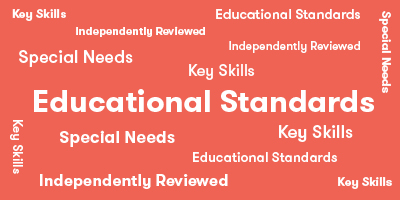
Core Standard*: Language
- Reading
- Phonics and Word Recognition: Grade Level 2nd
- Foundation Skills

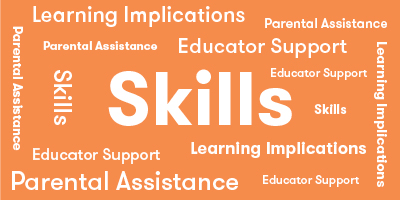
Determine
What Does Child Do To Use Skill In The Game?
Players need to decide what action or sound to make based on the card drawn.
How Parents Can Assist Learning
Ask children to state what they did correctly.
Learning Implications and Educator Support
Have a partner look at the sequence of cards on the table without revealing them to the playing child, and match it to the moves the playing child makes. As children take turns being the "checker" they are also demonstrating understanding of sequence.
Remember
What Does Child Do To Use Skill In The Game?
Players build short term memory by remembering and acting out the sequence of actions and sounds that are built by drawing and adding cards to an existing sequence.
How Parents Can Assist Learning
Everyone playing the game can practice memory. Have the child who is taking a turn name the cards in sequence. After the child moves through the sequence by making sounds and/or actions, the other players vote on whether it was correct. The teacher or another player checks the card sequence.
Learning Implications and Educator Support
Everyone playing the game can practice memory. Have the child who is taking a turn name the cards in sequence. After the child moves through the sequence by making sounds and/or actions, the other players vote on whether it was correct. The teacher or another player checks the card sequence.
Practice
What Does Child Do To Use Skill In The Game?
Each time a player acts out the sequence correctly, they are practicing to strengthen memory.
How Parents Can Assist Learning
Everyone playing the game can practice memory. Have the child who is taking a turn name the cards in sequence. After the child moves through the sequence by making sounds and/or actions, the other players vote on whether it was correct. The parent or another player checks the card sequence.
Learning Implications and Educator Support
Everyone playing the game can practice memory. Have the child who is taking a turn name the cards in sequence. After the child moves through the sequence by making sounds and/or actions, the other players vote on whether it was correct. The teacher or another player checks the card sequence.
Review
What Does Child Do To Use Skill In The Game?
Observers review the accuracy of the player's ability to repeat the sequence of sounds and/or actions on their turn in Do It Again
How Parents Can Assist Learning
Have the child who is taking a turn name the cards in sequence. After the child moves through the sequence by making sounds and/or actions, the other players vote on whether it was correct. The teacher or another player checks the card sequence.
Learning Implications and Educator Support
Do It Again is good for developing focus and self control not only for the player who has to repeat the sequence, but also for the observers who need to determine if the player did the sequence correctly. Educators can enhance this skill development by having the child who is taking a turn name the cards in sequence. After the child moves through the sequence by making sounds and/or actions, the other players vote on whether it was correct. The teacher or another player checks the card sequence.
Demonstrate
What Does Child Do To Use Skill In The Game?
Players demonstrate their ability to recall the sequence of cards by accurately replicating the sequence, including the new card they have drawn.
How Parents Can Assist Learning
This game is a good for demonstrating memory for sounds and/or actions. If the player can't remember what comes next in the sequence, ask other children to say what the next action or sound should be.
Learning Implications and Educator Support
Allow peers who are good at remembering the card sequence to partner with children who are not as good. Encourage them to follow the child's lead and only assist when needed. Give clues to help the child remember.
Imagine
What Does Child Do To Use Skill In The Game?
To envision unique or unusual ideas. What new ideas can I think of?
How Parents Can Assist Learning
No special adult support required
Learning Implications and Educator Support
No special adult support required
Create
What Does Child Do To Use Skill In The Game?
Do It Again involves a little creativity as players respond to certain cards by pretending to be an alligator, for example.
How Parents Can Assist Learning
No special adult support required
Learning Implications and Educator Support
No special adult support required
*Data compiled from CCSSI ELA Standards, WA Science Standards, and Washington Social Studies Standards

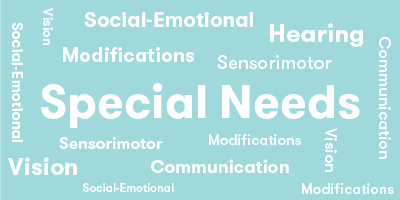
Cognitive
Suggestions for How to Modify Play Experience
Remembering action sequences may be easier for children with cognitive delays than remembering abstract sequences such as numbers or letters. Do It Again gives children a fun way to practice memory skills. Children with cognitive delays may have a harder time remembering more than two actions. If this is the case start with a limit of three cards before starting over. Gradually add cards to the sequence length as the child learns the game and practices watching and listening.
Make the game more cooperative by giving the child with cognitive delays clues. For example, "It (shake someone's hand) is something you do with your hand." The prompt may help the child remember the actions.
Communication
Suggestions for How to Modify Play Experience
The game involves movements and sounds, so talking is not needed. This makes Do It Again a good game for children who may not be able to repeat verbal sequences due to language concerns.
Many of the cards in Do It Again require making animal or other sounds or facial expressions. These type of activities provide excellent practice for children with language or speech issues. Do It Again also provides opportunities for children with communication difficulties to demonstrate their strength with physical actions and nonverbal communication.
Sensorimotor
Suggestions for How to Modify Play Experience
If children have difficulty with fine and gross motor movements or mouth movements, Do It Again may be challenging. On the other hand, the actions are fun and provide incentive for children to try new actions. Players can agree to enable close approximations to count for these children.
If the child has a specific type of motor difficulty, cards that require these movements can be removed. For example, if the child has difficulty with precise fine motor movements, remove cards such as "Snap your fingers." Many of the movements required are gross motor (ex:"Hop once on one foot"). If any of these are an issue remove the cards.
Social Emotional/Behavioral
Suggestions for How to Modify Play Experience
For children with impulsive behaviors, the "No Action!" cards may be frustrating. Eliminate a significant number of these cards to make the actions of the game move more quickly.
Vision
Suggestions for How to Modify Play Experience
Have the cards read by another player, so the child with vision impairments can play.
Hearing
Suggestions for How to Modify Play Experience
Children with hearing impairments may be able to play the game without modification of the movement cards. If there are sounds the child would not know or be able to make, remove these cards.
Most children who are deaf or hard of hearing should be able to play Do It Again with little modification. The game gives them an opportunity to communicate with gestures and movements and demonstrate their physical sequencing skills.
*Data compiled from CCSSI ELA Standards, WA Science Standards, and Washington Social Studies Standards

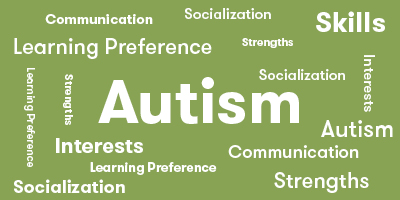
Autism Strengths & Interests
Short Summary of Strengths & Interests
- Has good memory skills
- Can sequence a series of actions.
- Has good fine motor, gross motor, mouth and facial movement skills.
Is good at matching visual items
This game is not appropriate
Has a good memory for sensory details, including visual, touch, taste and smell
Is This Game Appropriate? Yes
Description
Players need to remember a sequence of actions or sounds involving touch, sound, and movement.
Has a good memory for words, phrases and dialouge
This game is not appropriate
Has a good memory for pictures, numbers and patterns
This game is not appropriate
Likes to put things in order or a sequence
Is This Game Appropriate? Yes
Description
This game is all about sequencing. However, many children with autism like to sequence or arrange the same items. Do It Again involves sequencing unrelated actions. This may help children with autism break some repetitive actions.
Learns through visualizing or "replaying" actions in their mind
Is This Game Appropriate? Yes
Description
The way children remember the action sequence is to visualize what other players have performed in their minds. Using visual replay is a strength for many children with autism.
Likes activities with rules, such as math and phonics
This game is not appropriate
Is very concrete and literal
Is This Game Appropriate? Yes
Description
Do It Again is very concrete and literal as players perform the actions and noises written on the cards.
Learns in small "chunks" (for example, phone numbers are 3 chunks of number xxx-xxx-xxxx that are combined together)
Is This Game Appropriate? Yes
Description
Each round of play involves a "chunk" of actions with one additional action in each turn. Thinking of the actions in this way can help children remember.
Is good at nonverbal reasoning and logic
This game is not appropriate
Likes spatial problem solving
Can read well with good vocabulary, though may not fully comprehend content
Is This Game Appropriate? Yes
Description
Players need to be able to read the cards drawn to know what actions to perform. This game is not appropriate
Likes to use and has good fine motor skill
Is This Game Appropriate? Yes
Description
There is not a lot of fine motor activity in the game, but some of the actions required involve dexterity, such as "Snap your fingers."
Likes established routines or set ways of doing things
This game is not appropriate
Likes manipulating, constructing or building things
This game is not appropriate
Likes to use and has good musical abilities
This game is not appropriate
Likes to use and has good drawing skills
This game is not appropriate
Autism Special Considerations
Appears to ignore other's communication and/or has difficulty giving eye contact to a communication partner
Is This Game Appropriate for Child with Characteristic? No
Can Child with Characteristic Play Game w/o Modification? No
Strategies for Developing Compensatory Skills:
Players need to play attention to others' actions to be able to remember the previous actions.
Has difficulty understanding complex verbal directions
Is This Game Appropriate for Child with Characteristic? No
Can Child with Characteristic Play Game w/o Modification? No
Strategies for Developing Compensatory Skills:
Players have to understand what they read.
Uses vocabulary inaccurately or demonstrates echolalia (repeating another's speech)
Is This Game Appropriate for Child with Characteristic? Yes
Can Child with Characteristic Play Game w/o Modification? Yes
Strategies for Developing Compensatory Skills:
As long as the echolalia does not interfere with actions, the child should be able to play. Remove the sound cards from the action deck of cards. If only actions are required, the sounds and verbalizations of the child with autism will not interfere with the required action sequences of the game.
Gets stuck repeating a verbal topic or physical actions and/or has difficulty attending to others' actions or topic.
Is This Game Appropriate for Child with Characteristic? No
Can Child with Characteristic Play Game w/o Modification? No
Strategies for Developing Compensatory Skills:
Remove the sound cards from the action deck of cards. If only actions are required, the sounds and verbalizations of the child with autism may not interfere with the required action sequences of the game. Alternatively, if the child has repetitive physical actions or sounds, other players can be asked to focus on the required action sequence and ignore extraneous movements or sounds that may be interjected. Prompt the child by asking, "What was the first card?" and "What was the second?"
Has difficulty producing speech/communication
Is This Game Appropriate for Child with Characteristic? Yes
Can Child with Characteristic Play Game w/o Modification? Yes
Strategies for Developing Compensatory Skills:
Players only need to produce animal sounds.
Has difficulty sequencing multi-step actions and/or doing complex abstract tasks
Is This Game Appropriate for Child with Characteristic? No
Can Child with Characteristic Play Game w/o Modification? No
Strategies for Developing Compensatory Skills:
The game requires repeating an action and sound sequence.
Demonstrates difficulty initiating and maintaining social interactions
Is This Game Appropriate for Child with Characteristic? No
Can Child with Characteristic Play Game w/o Modification? Non>
Strategies for Developing Compensatory Skills:
Do It Again requires ongoing social interaction. This may be difficult for some children with autism.
Acts out or demonstrates avoidance behaviors when frustrated, overwhelmed, or needs more sensory input.
Is This Game Appropriate for Child with Characteristic? Yes
Can Child with Characteristic Play Game w/o Modification? No
Strategies for Developing Compensatory Skills:
Because of the constant movement involved in Do It Again, children with autism may be able to incorporate needed movement within the game. Encourage them to think about the next actions that will be drawn.
Has short attention span for non-preferred activities
Is This Game Appropriate for Child with Characteristic? Yes
Can Child with Characteristic Play Game w/o Modification? No
Strategies for Developing Compensatory Skills:
If the child does not like imitating actions and sounds of others, this may not be a good choice of games. On the other hand, the child who likes movement may be able to begin to imitate actions he enjoys making. Eliminate cards that are non-preferred actions or sounds.
Needs sameness or consistent routines and/or has difficulty with transitions from one activity to another
Is This Game Appropriate for Child with Characteristic? No
Can Child with Characteristic Play Game w/o Modification? No
Strategies for Developing Compensatory Skills:
Each card drawn is unpredictable.
Has difficulty understanding others' feelings, intentions, and the reasons for others' actions.
Is This Game Appropriate for Child with Characteristic? Yes
Can Child with Characteristic Play Game w/o Modification? Yes
Strategies for Developing Compensatory Skills:
Players do not need to understand the reasons behind actions in this game. The actions are done with no particular reason. Do It Again may be a good way to encourage paying attention to others without the demands of understanding underlying feelings.
*Data compiled from CCSSI ELA Standards, WA Science Standards, and Washington Social Studies Standards

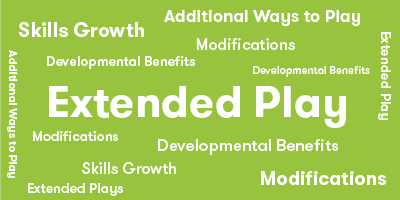
Extra Ways to Play the Game
Turn "No Action" into a wild card. You can just pass your turn or make up your own action to add to or start a sequence
Materials Needed
No additional materials are needed
Developmental Benefits
This adds an element of creativity to the game. Children may come up with crazy actions or noises to add to the fun of the game.
Extra Ways to Play the Game
To make the game a little more challenging, remove half or more of the "No Action" cards
Materials Needed
No additional materials are needed
Developmental Benefits
Removing the "No Action" cards makes the probability of having to act out a sequence of actions greater. This makes the game move more quickly and with more actions.
Extra Ways to Play the Game
To make game more challenging, you get to switch 2 cards in a sequence without looking at them. A player can make this switch if it is their turn and the card drawn is a number 5.
Materials Needed
No additional materials are needed
Developmental Benefits
To help with memory development, adults can suggest players try to associate the action with the number on the cards.
*Data compiled from CCSSI ELA Standards, WA Science Standards, and Washington Social Studies Standards
Game Details
- 65 Sequence Cards
- 1 Do It Again Pawn
- 1 Rules Booklet
- Choosing a selection results in a full page refresh.
- Opens in a new window.





